 W
WAerial ramming or air ramming is the ramming of one aircraft with another. It is a last-ditch tactic in air combat, sometimes used when all else has failed. Long before the invention of aircraft, ramming tactics in naval warfare and ground warfare were common. The first aerial ramming was performed by Pyotr Nesterov in 1914 during the First World War. In the early stages of World War II the tactic was employed by Soviet pilots, who called it taran, the Russian word for "battering ram".
 W
WAir supremacy is a degree of air superiority where a side holds complete control of air power over opposing forces. There are levels of control of the air in warfare. Control of the air is the aerial equivalent of command of the sea.
 W
WAttaque à outrance was the expression of a military philosophy common to many armies in the period before and during the earlier parts of World War I.
 W
WIn German military history, Bandenbekämpfung refers to the concept and military doctrine of countering resistance or insurrection in the rear area during wartime through extreme brutality. The doctrine provided a rationale for disregarding the established laws of war and for targeting of any number of groups, from armed guerrillas to the civilian population, as "bandits" or "members of gangs". As applied by the German Empire and later by Nazi Germany, it became instrumental in the mass crimes against humanity committed by the two regimes, including the Herero and Namaqua genocide and the Holocaust.
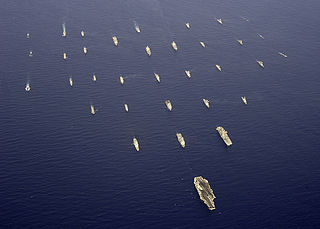 W
WA blue-water navy is a maritime force capable of operating globally, essentially across the deep waters of open oceans. While definitions of what actually constitutes such a force vary, there is a requirement for the ability to exercise sea control at long range.
 W
WCivilian control of the military is a doctrine in military and political science that places ultimate responsibility for a country's strategic decision-making in the hands of the civilian political leadership, rather than professional military officers.
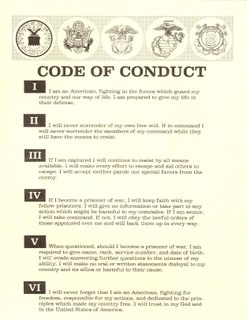 W
WThe Code of the U.S. Fighting Force is a code of conduct that is an ethics guide and a United States Department of Defense directive consisting of six articles to members of the United States Armed Forces, addressing how they should act in combat when they must evade capture, resist while a prisoner or escape from the enemy. It is considered an important part of U.S. military doctrine and tradition, but is not formal military law in the manner of the Uniform Code of Military Justice or public international law, such as the Geneva Conventions.
 W
WThe combat box was a tactical formation used by heavy (strategic) bombers of the U.S. Army Air Forces during World War II. The combat box was also referred to as a "staggered formation". Its defensive purpose was in massing the firepower of the bombers' guns, while offensively it concentrated the release of bombs on a target.
 W
WIn current military use, combined operations are operations conducted by forces of two or more allied nations acting together for the accomplishment of a common strategy, a strategic and operational and sometimes tactical cooperation. Interaction between units and formations of the land, naval and air forces, or the cooperation between military and civilian authorities in peacekeeping or disaster relief operations is known as joint operations or interoperability capability.
 W
WCommand of the sea is a naval military concept regarding the strength of a particular navy to a specific naval area it controls. A navy has command of the sea when it is so strong that its rivals cannot attack it directly. This dominance may apply to its surrounding waters or may extend far into the oceans, meaning the country has a blue-water navy. It is the naval equivalent of air supremacy.
 W
WJapan's Continental Policy refers to a Pan-Asian strategy pursued by Japan, especially the Imperial Japanese Army, between the Meiji Restoration and Japan's expansion during World War II. The policy's major aim was to conquer Japan's neighboring countries such as Korea and China to dominate East Asia.
 W
WCounterinsurgency (COIN) is generally used to refer to "the totality of actions aimed at defeating irregular forces". The Oxford English Dictionary defines counterinsurgency as any "military or political action taken against the activities of guerrillas or revolutionaries" and can be considered war by a state against a non-state adversary. Insurgency and counterinsurgency campaigns have been waged since ancient history. However, modern thinking on counterinsurgency was developed during decolonization. Within the military sciences, counterinsurgency is one of the main operational approaches of irregular warfare.
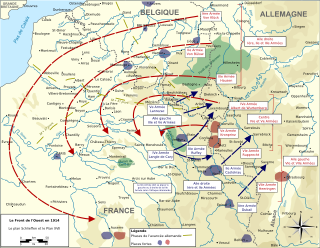 W
WThe cult of the offensive refers to a strategic military dilemma in which leaders believe that offensive advantages are so great that a defending force would have no hope of repelling the attack and therefore choose to attack. It is most often used to explain the causes of World War I and the subsequent heavy losses that occurred year after year, on all sides, during the fighting on the Western Front.
 W
WIn international politics, defence diplomacy refers to the pursuit of foreign policy objectives through the peaceful employment of defence resources and capabilities.
 W
WFirepower is the military capability to direct force at an enemy. Firepower involves the whole range of potential weapons. The concept is generally taught as one of the three key principles of modern warfare wherein the enemy forces are destroyed or have their will to fight negated by sufficient and preferably overwhelming use of force as a result of combat operations.
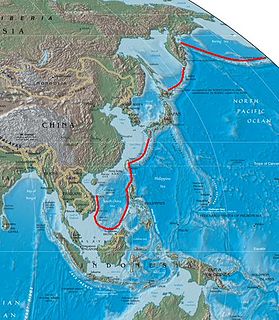 W
WThe first island chain refers to the first chain of major archipelagos out from the East Asian continental mainland coast. It is principally composed of the Kuril Islands, the Japanese Archipelago, the Ryukyu Islands, Taiwan (Formosa), the northern Philippines, and Borneo, hence extending all the way from the Kamchatka Peninsula in the northeast to the Malay Peninsula in the southwest. Some definitions of the first island chain anchor the northern end on the Russian Far East coast north of Sakhalin Island, with Sakhalin Island being the first link in the chain. However, others consider the Aleutians as the farthest north-eastern first link in the chain. The first island chain forms one of three island chain doctrines within the Island Chain Strategy in US foreign policy.
 W
WIn naval warfare, a "fleet in being" is a naval force that extends a controlling influence without ever leaving port. Were the fleet to leave port and face the enemy, it might lose in battle and no longer influence the enemy's actions, but while it remains safely in port, the enemy is forced to continually deploy forces to guard against it. A "fleet in being" can be part of a sea denial doctrine, but not one of sea control.
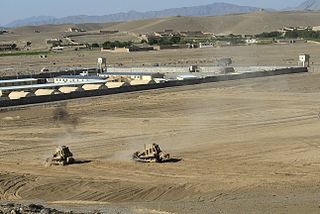 W
WA Forward Operating Base (FOB) is any secured forward operational level military position, commonly a military base, that is used to support strategic goals and tactical objectives. A FOB may or may not contain an airfield, hospital, machine shop, or other logistical facilities. The base may be used for an extended period of time. FOBs are traditionally supported by main operating bases that are required to provide backup support to them. A FOB also improves reaction time to local areas as opposed to having all troops on the main operating base.
 W
WAn insurgency is a violent, armed rebellion against authority when those taking part in the rebellion are not recognized as belligerents. An insurgency can be fought via counter-insurgency warfare, and may also be opposed by measures to protect the population and by political and economic actions of various kinds, as well as propaganda aimed at undermining the insurgents' claims against the incumbent regime. As a concept, insurgency's nature is ambiguous.
 W
WISTAR stands for intelligence, surveillance, target acquisition, and reconnaissance. In its macroscopic sense, ISTAR is a practice that links several battlefield functions together to assist a combat force in employing its sensors and managing the information they gather.
 W
WIn military history, the German term Kampfgruppe can refer to a combat formation of any kind, but most usually to that employed by the Wehrmacht of Nazi Germany and its allies during World War II and, to a lesser extent, of the German Empire in World War I.
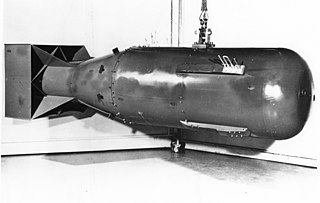 W
WLaunch on warning (LOW) or fire on warning is a strategy of nuclear weapon retaliation that gained recognition during the Cold War between the Soviet Union and the United States. With the invention of intercontinental ballistic missiles (ICBMs), launch on warning became an integral part of mutually assured destruction (MAD) theory. Under the strategy, a retaliatory strike is launched upon warning of enemy nuclear attack while its missiles are still in the air and before detonation occurs. US land-based missiles can reportedly be launched within five minutes of a presidential decision to do so and submarine-based missiles within 15 minutes.
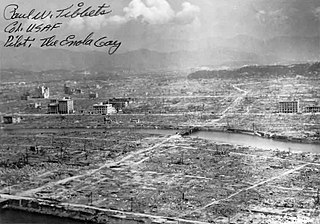 W
WMutually assured destruction (MAD) is a doctrine of military strategy and national security policy in which a full-scale use of nuclear weapons by two or more opposing sides would cause the complete annihilation of both the attacker and the defender. It is based on the theory of deterrence, which holds that the threat of using strong weapons against the enemy prevents the enemy's use of those same weapons. The strategy is a form of Nash equilibrium in which, once armed, neither side has any incentive to initiate a conflict or to disarm.
 W
WNo first use (NFU) refers to a pledge or a policy by a nuclear power not to use nuclear weapons as a means of warfare unless first attacked by an adversary using nuclear weapons. This concept is also applied to chemical and biological warfare in case of the NFU policy of India.
 W
WPower projection is a term used in military and political science to refer to the capacity of a state to deploy and sustain forces outside its territory.
 W
WIn nuclear strategy, a first strike is a preemptive surprise attack employing overwhelming force. First strike capability is a country's ability to defeat another nuclear power by destroying its arsenal to the point where the attacking country can survive the weakened retaliation while the opposing side is left unable to continue war. The preferred methodology is to attack the opponent's strategic nuclear weapon facilities, command and control sites, and storage depots first. The strategy is called counterforce.
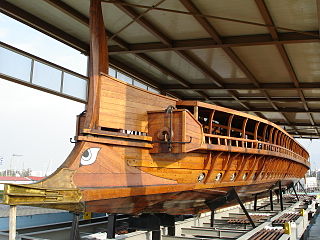 W
WIn warfare, ramming is a technique used in air, sea, and land combat. The term originated from battering ram, a siege weapon used to bring down fortifications by hitting it with the force of the ram's momentum, and ultimately from male sheep. Thus, in warfare, ramming refers to hitting a target by running oneself into the target.
 W
WThe Reagan Doctrine was stated by United States President Ronald Reagan in his State of the Union address on February 6, 1985: "We must not break faith with those who are risking their lives--on every continent from Afghanistan to Nicaragua—to defy Soviet-supported aggression and secure rights which have been ours from birth." It was a strategy implemented by the Reagan Administration to overwhelm the global influence of the Soviet Union in the late Cold War. The doctrine was a centerpiece of United States foreign policy from the early 1980s until the end of the Cold War in 1991.
 W
WThe Russian Navy is the naval arm of the Russian Armed Forces. It has existed in various forms since 1696, the present iteration of which was formed in January 1992 when it succeeded the Navy of the Commonwealth of Independent States.
 W
WStrategic bombing is a military strategy used in total war with the goal of defeating the enemy by destroying its morale, its economic ability to produce and transport materiel to the theatres of military operations, or both. It is a systematically organized and executed attack from the air which can utilize strategic bombers, long- or medium-range missiles, or nuclear-armed fighter-bomber aircraft to attack targets deemed vital to the enemy's war-making capability.
 W
WSuppression of Enemy Air Defenses (SEAD, pronounced ), also known in the United States as "Wild Weasel" and (initially) "Iron Hand" operations, are military actions to suppress enemy surface-based air defenses, including not only surface-to-air missiles (SAMs) and anti-aircraft artillery (AAA) but also interrelated systems such as early-warning radar and command, control and communication (C3) functions, while also marking other targets to be destroyed by an air strike. Suppression can be accomplished both by physically destroying the systems or by disrupting and deceiving them through electronic warfare. In modern warfare SEAD missions can constitute as much as 30% of all sorties launched in the first week of combat and continue at a reduced rate through the rest of a campaign. One quarter of American combat sorties in recent conflicts have been SEAD missions.
 W
WTotal war is warfare that includes any and all civilian-associated resources and infrastructure as legitimate military targets, mobilizes all of the resources of society to fight the war, and gives priority to warfare over non-combatant needs.
 W
WTrench warfare is a type of land warfare using occupied fighting lines largely comprising military trenches, in which troops are well-protected from the enemy's small arms fire and are substantially sheltered from artillery. Trench warfare became archetypically associated with World War I (1914–1918), when the Race to the Sea rapidly expanded trench use on the Western Front starting in September 1914.
 W
WUnrestricted submarine warfare is a type of naval warfare in which submarines sink vessels such as freighters and tankers without warning, as opposed to attacks per prize rules.